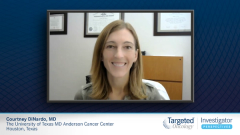
Unmet Needs of AML and Advice for Community Oncologists
Courtney DiNardo, MD, concludes with discussing some challenges faced when treating patients with AML and shares some advice for community oncologists treating acute myeloid leukemia.
Courtney DiNardo, MD: The combination of azacytidine and venetoclax has been paradigm shifting in our older intensive-chemotherapy-ineligible patients because it’s the first time in decades that we’ve improved our standard of care. This has become our de facto standard of care throughout the world for our newly diagnosed patients with AML [acute myeloid leukemia], but not everyone is going to be cured with this therapy. Unfortunately, a minority of patients will be cured with this therapy. There are definitely ongoing unmet needs. Even though this is a great step ahead, we’re not done. We still need to improve these.
One thing I’m interested in, and that are in ongoing trials, is figuring out which patients have FLT3, IDH1, and TP53 mutations and other things that we can potentially target. Can we add that to the azacytidine-venetoclax regimen to make it even more effective? How do we improve upon the outcomes in some of these higher-risk sufferers? The other question you asked me is if there are other therapies that I’d consider.
I want to highlight the fact that there’s a new FDA approval for the combination of azacytidine and ivosidenib, which is an IDH1 inhibitor for the 8% or so of patients who are IDH1 mutated. That’s a very compelling, well-tolerated combination. At [The University of Texas] MD Anderson [Cancer Center], which is where I practice, we’re fortunate in that we have targeted panels returning in 3 to 5 days. We can use that information to identify the best treatment option for our patients and incorporate targeted therapies if appropriate and available. That’s another great option.
In the first month is when you’re going to get a sense of how your patient is going to respond to azacytidine and venetoclax. Monitor them with blood counts twice a week during their second, third, and fourth week of [INAUDIBLE]. Get a sense of how many transfusions they need. Make sure you’re doing the end of cycle 1 bone marrow because that’s going to help you determine how to go about continuing therapy in a well-tolerated way for your patients. I have all my patients on a fluoroquinolone prophylaxis, levofloxacin in particular, because there are no CYP interactions.
That leads me to the last comment, which is to make sure you’re aware of drug-drug interactions. Because of that CYP interaction, you really need to know if your patient is on an azole or even a ciprofloxacin, which is a moderate CYP inhibitor. There are adjustments. If your patient is on a moderate CYP inhibitor, then you have to drop the venetoclax dose by 50%. It’s important that you’re not compounding myelosuppression and cytopenias in patients to make sure this therapy is well tolerated. It’s very effective, and patients are definitely benefiting from this therapy, but you want to make sure you’re using it in an optimized way.
Transcript edited for clarity.










































